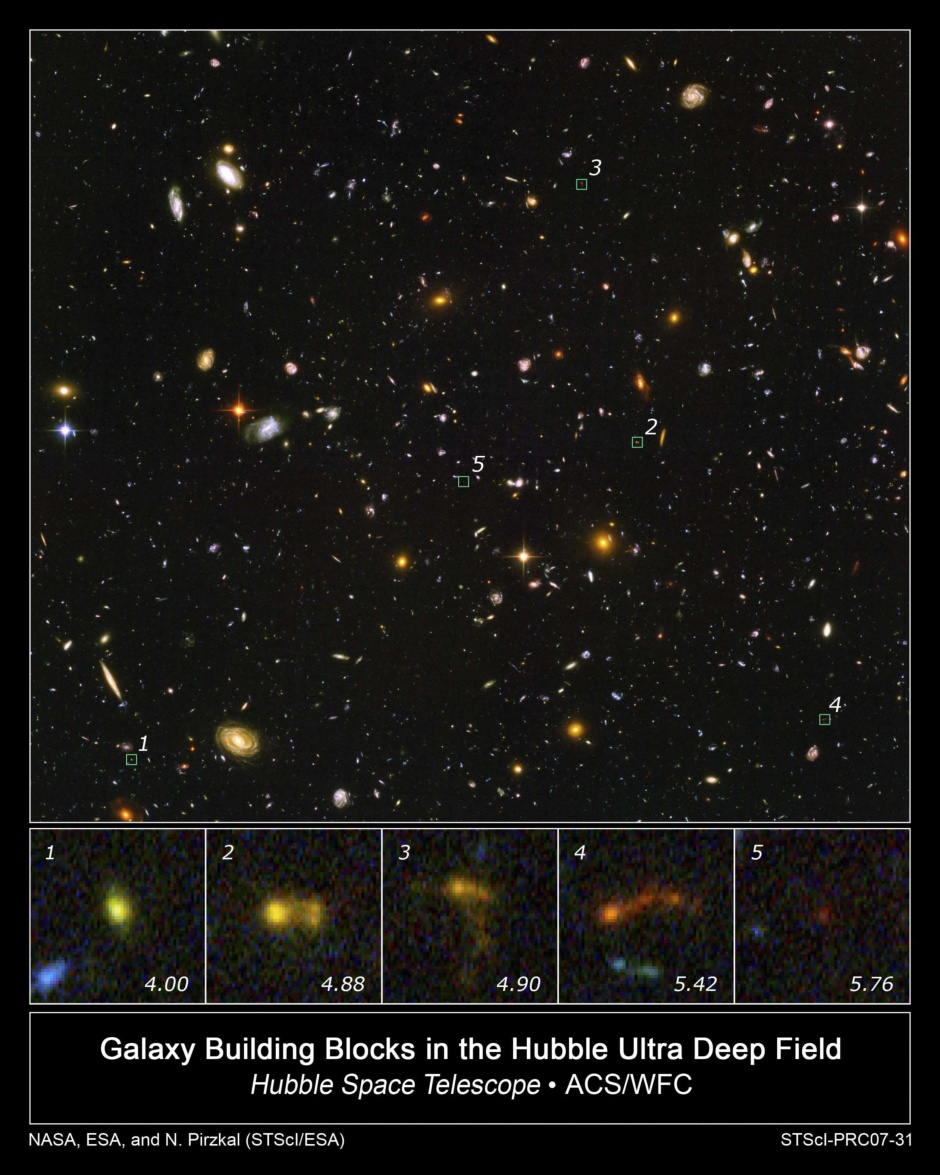NASA의 허블우주망원경과 스피처 우주망원경이 지금까지 관측된 우주에서 가장 멀리 위치한 은하들 중, 가장 작고 희미한 9개의 은하를 발견하였다.
이번에 발견된 은하들은 우리의 은하보다 수백배에서 수천배 작은 은하들로서 수백만개의 별들에서 쏟아내는 빛으로 눈부시게 빛나고 있다.
메릴랜드 볼티모어의 우주망원경과학연구소(Space Telescope Science Institute)와 유럽우주항공국에서 근무하는 노어 피르츠칼(Nor Pirzkal)은 이것들은 지금까지 직접 관찰된 초기 우주에서 가장 작은 국부은하군들이라고 말한다.
은하진화의 표준모델은 초기 우주의 작은 은하들이 그보다 거대한 오늘날과 같은 은하들에 합체되어 생성되었다고 예측하고 있다.
허블에 의해 처음 관측된 이들 9개의 은하들은 우리의 우주건축에 한 몫 차지하고 있는 레고 조각과 같은 블럭들이다.
피르츠칼은 이 은하들의 예측 규모가 너무나도 작은 것에 놀랐다.
이들의 보다 정확한 규모는 허블의 사촌격인 스피처 우주망원경에 의해 측정되었다.
그리고 스피처 우주망원경은 이들 은하들이 우주의 가장 작은 '블럭'들이라는 점을 확신시켜주었다.
이들 젊은 은하들은 빅뱅이 발생한지 불과 10억년 이후의 고대 우주의 광경을 보여주고 있다.
허블은 아홉 개의 원시 은하에 속한 사파이어블루색깔의 별들을 관측했다.
불과 몇 백만 년밖에 되지 않은 이들 어린 별들은 빅뱅으로부터 발생한 원소들(수소와 헬륨)을 그보다 무거운 원소로 변환시키는 중에 있다.
이들 별들은 아직 주변공간이 다른 원소들로 영향받지는 않았을 것이다.
관측자 중 한명인 아리조나 주립대학의 Sangeeta Malhotra는
"이 어린 별들의 푸른빛이 허블에 의해 관측되는 동안 스피처 망원경의 이미지는 이들로부터 적외선이 방출되지 않음을 보여줬는데 이는 이들이 지금까지 발견된 은하들 중 가장 어린 나이의 은하들임을 보여주는 증거"라고 말한다.
수소의 급격한 증가에 기인한 불빛을 뿜어내고 있는 이 은하들은 아리조나 주립대학의 James Rhoads와 중국 상하이 기술물리 연구소 Chun Xu에 의해 처음으로 확인되었다.
이 은하들 중 세 개는 둥근 방울모양이 아닌 올챙이 모양처럼 한 쪽으로 쭉 뻗어나간, 마치 붕괴되거나 분열되고 있는 듯한 모습을 보여주고 있다.
이것은 이들이 아마도 가까이에 위치한 은하들과 상호작용을 하고 있거나 충돌로 인해 더 크고 더 강력한 중력을 행사하는 큰 은하로 변해가고 있음을 의미한다.
이들 은하들은 허블의 Ultra Deep Field (HUDF)와 근적외선 카메라, 다중분광계에 의해 관측되었다.
또한 이 관측은 스피처 적외선배열 카메라와 유럽 남반구 천문대의 적외선분광계 다중카메라에 의해 수행되었다.
피르츠칼의 주요 동료들은 Malhotra, Rhoads, Xu 그리고 GRAPES(GRism ACS Program for Extragalactic Science) 팀이다.
* '허블사이트'의 게시물들은 허블공식 사이트 http://hubblesite.org 의 글들을 기반으로 약간의 편집을 거쳐 만들어집니다.
이 뉴스는 2007년 9월 6일 발표되었습니다.
http://hubblesite.org/newscenter/archive/releases/2007/31/full/
원문>
NASA's Hubble and Spitzer Space Telescopes have joined forces to discover nine of the smallest, faintest, most compact galaxies ever observed in the distant universe. Blazing with the brilliance of millions of stars, each of the newly discovered galaxies is a hundred to a thousand times smaller than our Milky Way Galaxy.
"These are among the lowest mass galaxies ever directly observed in the early universe," says Nor Pirzkal of the Space Telescope Science Institute and the European Space Agency in Baltimore, Md.
The conventional model for galaxy evolution predicts that small galaxies in the early universe evolved into the massive galaxies of today by coalescing. These nine Lego-like "building block" galaxies initially detected by Hubble likely contributed to the construction of the universe as we know it.
Pirzkal was surprised to find that the galaxies' estimated masses were so small. Hubble's cousin observatory, NASA's Spitzer Space Telescope was called upon to make precise determinations of their masses. The Spitzer observations confirmed that these galaxies are some of the smallest building blocks of the universe.
These young galaxies offer important new insights into the universe's formative years, just one billion years after the Big Bang. Hubble detected sapphire blue stars residing within the nine pristine galaxies. The youthful stars are just a few million years old and are in the process of turning Big Bang elements (primarily hydrogen and helium) into heavier elements. The stars have probably not yet begun to pollute the surrounding space with elemental products forged within their cores.
"While blue light seen by Hubble shows the presence of young stars, it is the absence of infrared light in the sensitive Spitzer images that was conclusive in showing that these are truly young galaxies without an earlier generation of stars," says Sangeeta Malhotra of Arizona State University in Tempe, Ariz., one of the investigators.
The galaxies were first identified by James Rhoads of Arizona State University and Chun Xu of the Shanghai Institute of Technical Physics in Shanghai, China, by their prominent and energetic light coming from glowing hydrogen. Three of the galaxies appear to be slightly disrupted - rather than being shaped like rounded blobs, they appear stretched into tadpole-like shapes. This is a sign that they may be interacting and merging with neighboring galaxies to form larger, cohesive structures.
The galaxies were observed in the Hubble Ultra Deep Field (HUDF) with Hubble's Advanced Camera for Surveys and the Near Infrared Camera and Multi-Object Spectrometer. Observations were also done with Spitzer's Infrared Array Camera and the European Southern Observatory's Infrared Spectrometer and Array Camera.
Pirzkal's main collaborators were Malhotra, Rhoads, Xu, and the GRism ACS Program for Extragalactic Science (GRAPES) team.
CONTACT
Nor Pirzkal
Space Telescope Science Institute, Baltimore, Md.
410-338-4879
npirzkal@stsci.edu
'3. 천문뉴스 > 허블사이트' 카테고리의 다른 글
| 별들의 요람 NGC 4449 (0) | 2007.09.19 |
|---|---|
| 젊은 별과 암석부스러기 Disk (0) | 2007.09.19 |
| 별의 최후의 흔적(행성상성운) (0) | 2007.09.19 |
| 베일 성운의 초신성 폭발 잔해 (0) | 2007.09.02 |
| 천왕성의 링 (0) | 2007.09.02 |
